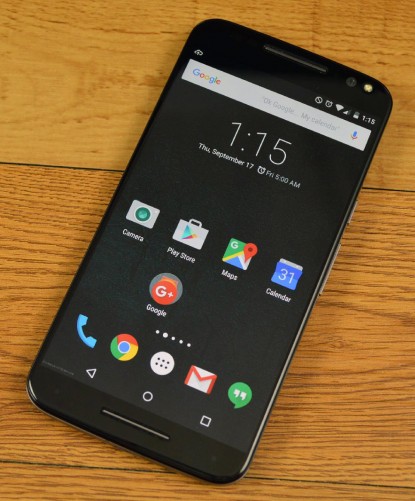How’s this for a smartphone sales hook? It’s a “just right” Android handset, with an above-average spec sheet, a reasonable off-contract price, and few flourishes or gimmicks.
With Android device makers turning to display edges, design curves, 4K displays, active styluses, and software tweaks to differentiate their offerings from one another, Motorola’s basic-is-better approach to hardware is refreshing, and it’s resulted in two generations of solid flagship devices in the Moto X line.
The latest, the Moto X Pure Edition, continues that trend, along with the line’s customization features, giving users a wide array of color options, and a few new build materials to boot. It also starts at $400 off contract, and works on just about every US carrier
.
That has to make the Moto X Pure Edition a real winner, right? Read on to find out.
Build & Design
Even with the most garish color combination, the Moto X is a good looking smartphone. It has a very thin bezel on both the right and left portrait sides, while adhering to the Android buttonless display trend. The ear and mouth pieces double as the front facing speakers, located on the top and bottom bezels, and they are joined by various infrared sensors, the 5-megapixel front-facing camera, and a front-facing camera flash, which is an uncommon but useful addition.
The Moto X Pure Edition measures 6 x 3 x .24-.43 inches (H x W x D) and weighs .39 pounds. It has a curved back, which aids ergonomics, though not enough to keep the smartphone from being unwieldy and awkward, especially when trying to operate with one hand. This is the trade-off for the big screen with every phablet.
The back houses the 21-megapixel rear camera located just above the flash/LED light. Both are contained in an oblong plastic accent, along with a small finger rest adorned with the Motorola logo. There are various pinhole mics along the back for recording audio during video.
The power button and single-piece volume rocker reside on one long side, while the USB 2.0 input sits on the bottom. The 3.5 audio jack and microSIM/microSD tray, which require pin removal, sit on the top.
We complained in the Galaxy Note5 review about USB 2.0. It’s old and time for the flagships to move past it. Given that the Moto X has a more modest price tag and spec sheet, we’ll give it a pass. The placement of the power button and volume rocker on the same side presents issues, however. Although the power button is textured, it’s tough to distinguish the two by touch, resulting in too many accidental power offs.

The basic Moto X Pure Edition features a soft grip back, which feels pleasant, though not as premium as other flagships. It easily scuffs and scratches.
Depending on the storage configuration, users can select from up to three color combinations for the frame and front (white/silver, white/champagne, black/gray), and seven choices for the accent. Users can also go with a “soft grip” back (slightly ribbed plastic with 10 color options), or you can choose from among 4 color options with wood or leather backs. Our review unit features the soft grip back, which feels pleasant, though not as premium as other flagships. It easily scuffs and scratches.
There is no removable battery, but the microSD card slot is a great addition that is missing from too many other smartphones. It’s water repellent, meaning it will shrug off spills and splashes, but shouldn’t be submerged. Overall, it feels solid with no creak or flex. It likely will survive a drop or two, but just as with any phone not specifically ruggedized, a case is a worthwhile investment. In fact, the Moto X Pure Edition ships with a clear plastic edge ring, which offers limited, but still welcomed, protection. Kudos to Motorola for including it.
Display & Speakers
The Moto X Pure Edition has a 5.7-inch IPS TFT LCD display with Gorilla Glass 3, and a 1440 x 2560 resolution, which translates into a density of 520 pixels per inch. This is a departure from the 2014 Moto X’s 5.2-inch AMOLED display, and even though the Pure Edition has a larger display with about 100 more pixels per inch, we can’t say it’s much of an improvement.
With these sizes and resolutions, it’s near impossible to discern the difference in pixel density, but AMOLED display technology is superior. It produces more vibrant colors and deeper blacks. For its part, LCD has come a long way, and the difference between the two isn’t as stark as it once was. Still, AMOLED is the better choice if image quality is your primary concern. LCD typically has cleaner whites, but our sample of the Moto X Pure Edition has a slight magenta tint.
Keep in mind that we’re nitpicking here. The Moto X Pure Edition has a fine display that’s just below the best of the best. Users won’t be disappointed, and it’s especially good at cutting through the type of glare found outdoors on a sunny day.
We’ll have to take Motorola at its word that this Moto X has stereo speakers, because at this size, the effect is hard to discern. Overall, the sound is cramped, which is common to every smartphone we’ve ever tested. They are plenty loud, and that makes them better than most.
